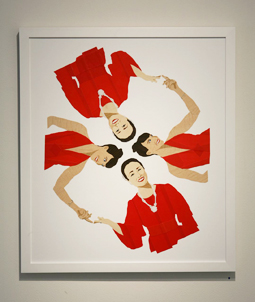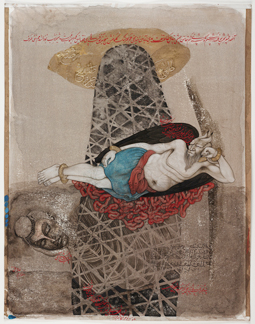 |
|
Focus features two in-depth reviews each month of fine art, architecture and design exhibitions and events at art museums, galleries and alternative spaces around Japan. The contributors are non-Japanese art critics living in Japan.
|
|
|
 |
 |
 |
The Long Residence: "Home Again" at the Hara Museum
Roger McDonald |
 |
 |
| Mary Elizabeth Yarbrough, Oh-me nee kakatte ureh-shee des! (I am glad that I meet you!), 2007, duct tape and contact paper on contact paper, 63 x 56 cm |
|
Japan has a rich and long history of artist-in-residence programs. Many artists from around the world have travelled to Japan to live and work, some under the auspices of formal regional or government programs, others via nonprofit initiatives, and still others through grassroots personal contacts. It was in the early 1990s that Japanese residence programs began to coalesce into a recognizable and public form. Pioneering examples would include ARCUS in Ibaraki Prefecture, which began a residence-based project in the early 1990s; IAMAS in Gifu Prefecture, which started inviting resident artists from the mid-1990s; and AIT (Arts Initiative Tokyo), which initiated one of the first structured programs in the capital in 2004. An excellent bilingual online resource covering Japanese artist-in-residence programs is AIR_J, compiled by the Japan Foundation in 2001.
Home Again -- 10 Artists Who Have Experienced Japan, at the Hara Museum of Contemporary Art in Tokyo, is an unusual exhibition in that it shows work by ten artists who had stayed in Japan through AIT's Backers residence program between 2007 and 2011. I say unusual because the majority of artists in residence programs tend to focus on a single stay in a particular place with various activities during that stay. Once the artist returns home it is often very difficult to maintain a close relationship with them due to lack of funds and the need to invite new faces. Home Again invited the ten resident artists back to Tokyo to show works that they had made while in Japan as well as new works inspired by their Japan stay. The exhibition thus perhaps also offers another model for how residency programs can be re-imagined in the future -- expanding the model of an intense singular stay to something more long-term and supportive of artists' practice over a longer time period.
 |
| Duto Hardono, Untitled (You Chose the Wrong Side), 2011, framed hand-stamped cassette tape, 36.0 x 21.2 cm |
|
Home Again is also unique in showing work by relatively young artists from parts of the world which are rarely seen in Japan -- places like Afghanistan and Argentina -- as well as more well-known countries like India and Brazil. The ambience of the Hara Museum, originally the home of the Hara family, resonates strongly with many of the works, which explore ideas and experiences about being away from home, loneliness, and memory. In the case of Duto Hardono and Syagini Ratnawulan of Indonesia, who came to Tokyo in April 2011 just after the Tohoku earthquake and tsunami, the residency was a time of both reflection and sadness, but also of renewal and discovery. Hardono's Popular Critics, an installation made in Tokyo, includes recorded laughter from television programs that sounds strangely haunting in light of its post-3.11 context. Other works in the exhibition explore a range of fascinations with Japan, from karaoke culture and the dizzying sense of the city, to traditional forms such as Noh theater, to discovered stories about foreign migrant workers and historical grassroots exchanges between Japanese and American children.
 |
Khadim Ali, The Haunted Lotus, 2011-2012, goauche and gold leaf on paper, 70 x 54 cm
All photos by Keizo Kioku, 2012
|
|
As art and the flow of artists become ever more global and compressed, artist-in-residence programs in Japan will undoubtedly also continue to evolve. Home Again shows the tangible results of a residency via what artists make, but also points to the more intangible, yet important, aspect of a commitment to sustain human relationships over time. In an age of branded cultural cities and the rapid movement of artists within them, it seems important to also consider residencies as something more tempered and layered, a space in which time is occupied and friendships sustained.
 |
 |
Roger McDonald
Roger McDonald was born and brought up in Tokyo, educated in the UK, and returned to live in Japan in 2000 after completing his PhD. He has worked on the Yokohama Triennale 2001 as assistant curator, the Singapore Biennale 2006 as curator, and organised a number of exhibitions and projects independently. He is deputy director of the non-profit curatorial collective Arts Initiative Tokyo, and teaches at Musashino and Joshibi Art Universities. |
|
 |
|